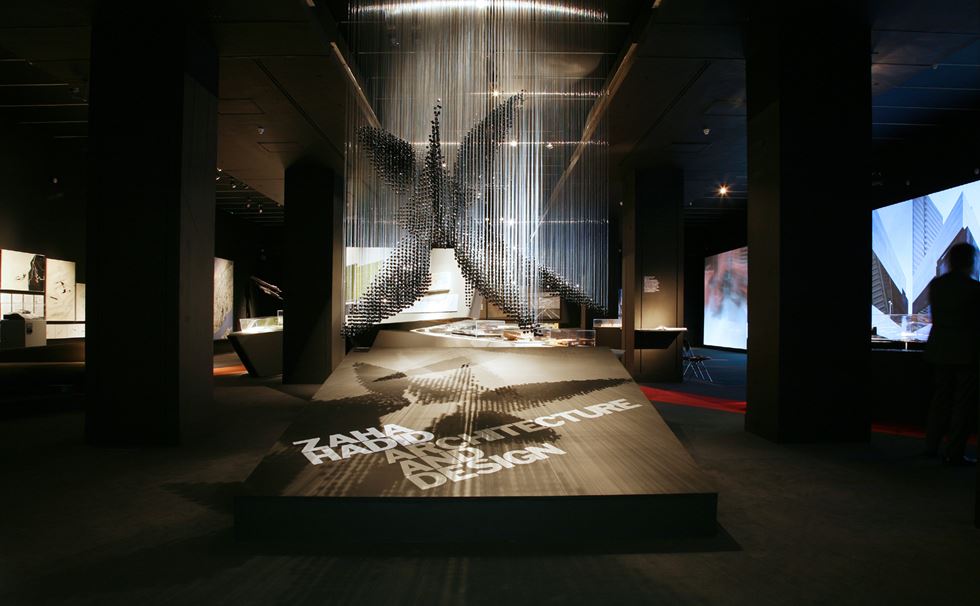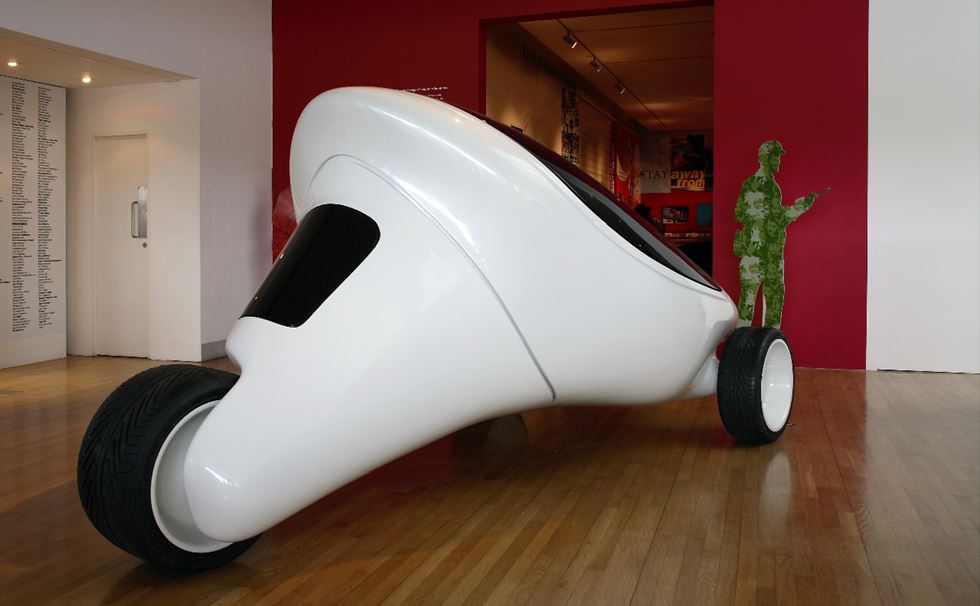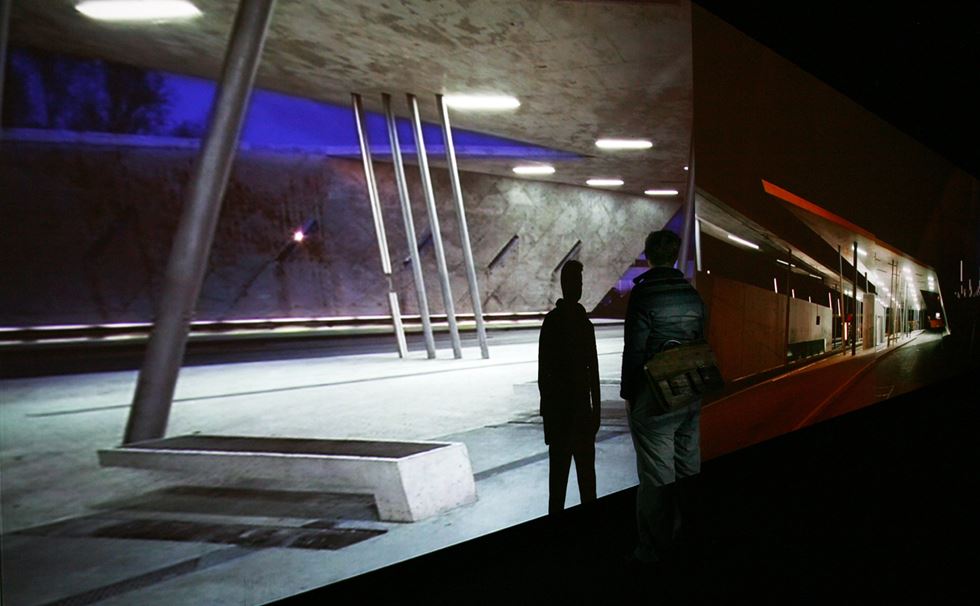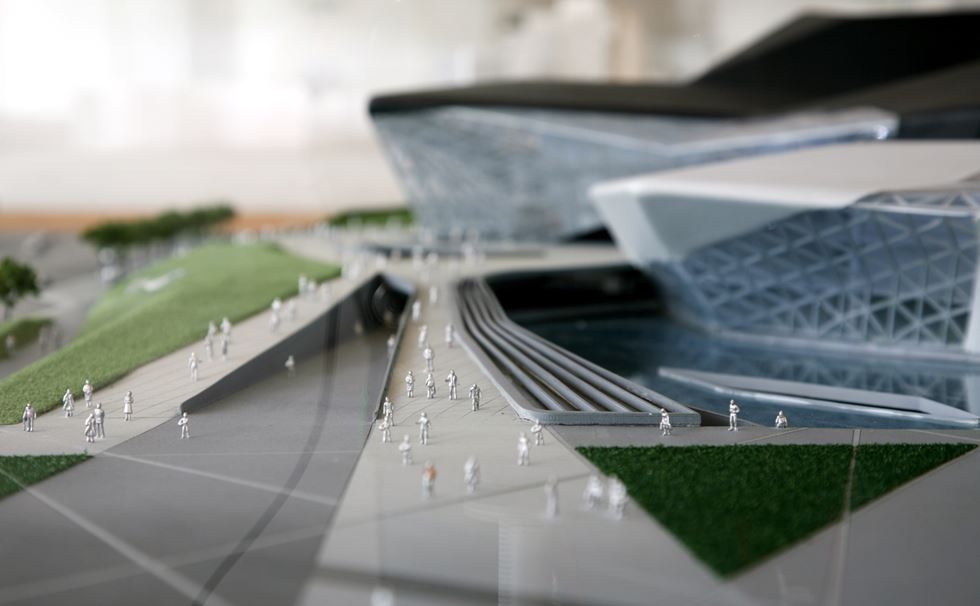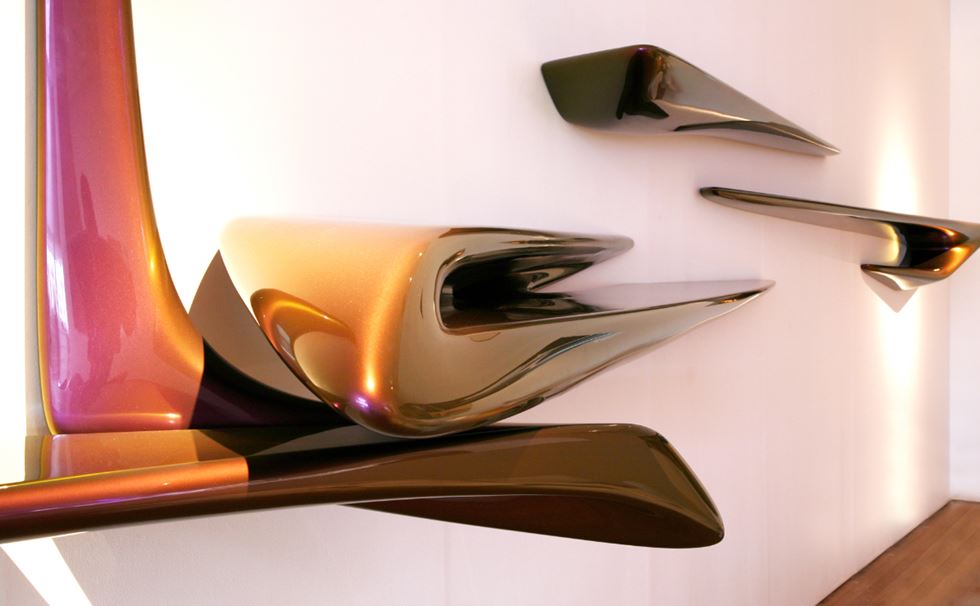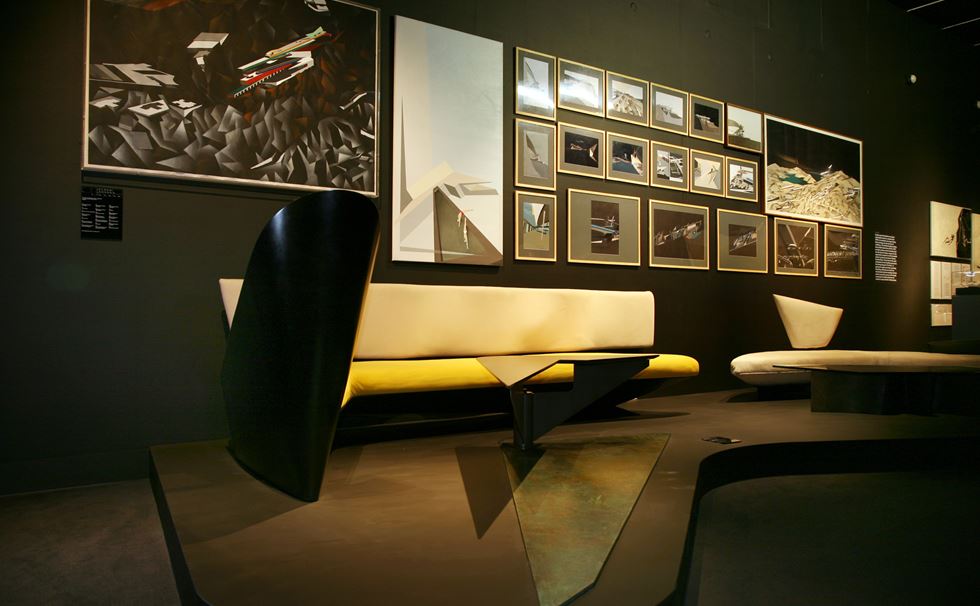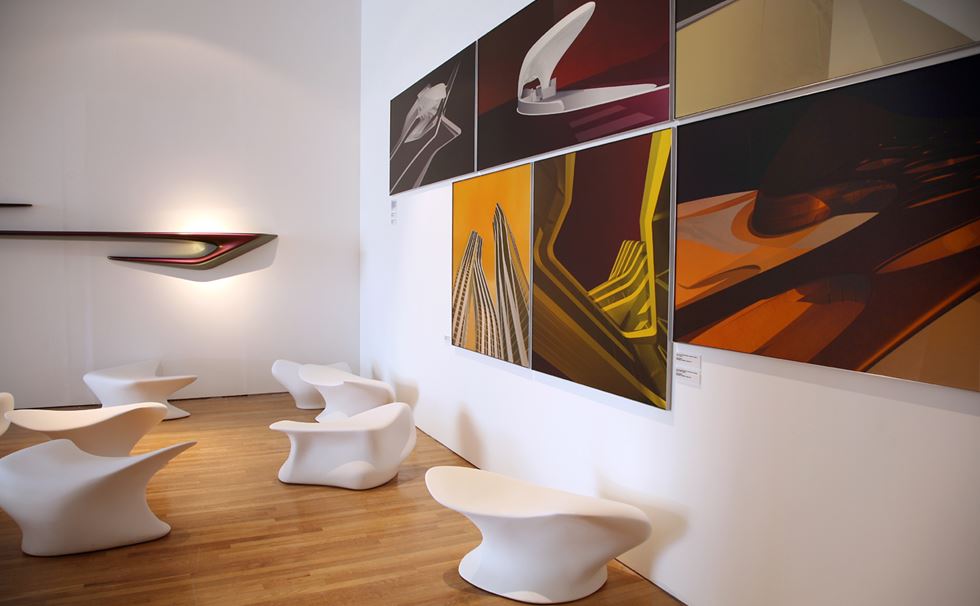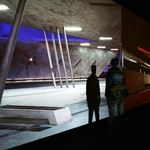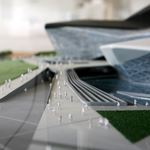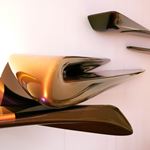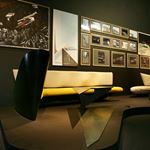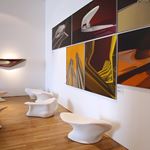Profile
Zaha Hadid
Transcendent architecture
The first woman to win the Pritzker Prize for Architecture, Zaha Hadid (1950–2016) defined a radically new approach to architecture by creating buildings such as the Rosenthal Center for Contemporary Art in Cincinnati, with multiple perspective points and fragmented geometry to evoke the chaos of modern life.
The opening words of the citation when Zaha Hadid was named as the first woman to win the prestigious Pritzker Prize for architecture in 2004 were: ‘Her architectural career has not been traditional or easy’. An understatement. All architects have to struggle, but Hadid seemed to have struggled rather more than most. Her single-mindedness, her singular lack of compromise is the stuff of legend, although, as one writer commented, like a hurricane, ‘the storms are all on the outside’. In part, it was simple artistic temperament, necessary, perhaps, to create forceful architecture like Hadid’s. And in part it was the survival mechanism required to create such architecture in what remains a distinctly macho profession. Diva, the critics called her, although as the T-shirts worn by Hadid staff replied at the opening of her first major public building, the Cincinnati Art Center, in 2003: ‘Would they call me a diva if I were a guy?’
Hadid’s forcefulness was both her curse and her blessing. A curse because strong character can make clients run for the hills. For a while, Hadid was more famous not for the buildings she had built, but for the ones she had not built — preserved only in her famously vigorous, dramatic images. Often, as in the case of the Cardiff Bay Opera House, these opportunities to build were lost quite spectacularly. In the end, though, her forcefulness was a blessing. Like architectural natural selection, it helped to weed out weak projects and weak clients, so that when architecture was finally built, it was as strong-willed as its creator.
Zaha Hadid was single-minded from an early age. Born in 1950 in Baghdad, she grew up in a very different Iraq from the one we know today. The Iraq of her childhood was a liberal, secular, western-focused country with a fast-growing economy that flourished until the Ba’ath party took power in 1963, and where her bourgeois intellectual family played a leading role. Hadid’s father was a politician, economist and industrialist, a co-founder of the Iraqi National Democratic and a leader of the Iraqi Progressive Democratic Parties. Hadid saw no reason why she should not be equally ambitious. Female role models were plentiful in liberal Iraq, but in architecture, female role models anywhere, let alone in the Middle East, were thin on the ground in the 1950s and 1960s. No matter. After convent school in Baghdad and Switzerland, and a degree in mathematics at the American University in Beirut, Hadid enrolled at the Architectural Association in London in 1972. The AA of the 1970s was the perfect place for ambitious, independently minded would-be architects to flourish. Under Alvin Boyarski as director, it became the most fertile place for the architectural imagination, home to a precocious generation of students and teachers who are now household names, such as Rem Koolhaas, Daniel Libeskind, Will Alsop and Bernard Tschumi. It was a period when pre-1968 optimistic modernism was being abandoned amid economic uncertainty and cultural conservatism. In architecture too, democratic modernism was perceived to have failed and there was a swing towards historicist post-modernism and conservation. The AA’s theorists did the opposite. They rejected kitsch post-modernism to become still more modernist. Like snakes shedding their skins, they discarded the failed utopian projects of ‘first’ modernism to think up a new modernism with a more sophisticated idea of history and human identity, an architecture embodying modernity’s chaos and disjuncture in its very shape.
If Hadid was drawn to any of her tutors it was Koolhaas, himself working out his ideas of neo-modernity in books such as 1977’s Delirious New York. When Hadid graduated in 1977, Koolhaas offered her a job as a partner in his and Elia Zenghelis’s new firm, the Office for Metropolitan Architecture. But she didn’t last long there. Koolhaas described her at the time as ‘a planet in her own orbit’. Hadid had her own ideas on architecture to nurture. And it was a long incubation. She started teaching at the AA while developing her own brand of neo-modernist architecture, one which went back to modernism’s roots in the constructivism and suprematism of the early 20th century. Her graduation project, a hotel on London’s Hungerford Bridge, was called Malevich’s Tectonik, after the suprematist Kasimir Malevich who wrote in 1928: ‘we can only perceive space when we break free from the earth, when the point of support disappears’. Hadid’s architecture followed suit, creating a landscape which metaphorically — and, perhaps, one day literally — seems to take off.
You could call her work baroque modernism. Baroque classicists like Borromini shattered Renaissance ideas of a single viewpoint perspective in favour of dizzying spaces designed to lift the eyes and the heart to God. Likewise, Hadid shattered both the classically formal, rule-bound modernism of Mies van der Rohe and Le Corbusier and the old rules of space — walls, ceilings, front and back, right angles. She then reassembled them as what she called ‘a new fluid kind of spatiality’ of multiple perspective points and fragmented geometry, designed to embody the chaotic fluidity of modern life.
Hadid’s architecture denied its own solidity. Short of creating actual forms that morph and change shape — still the stuff of science fiction — Hadid created the solid apparatus to make us perceive space as if it morphs and changes as we pass through. Perhaps wisely, she talked little about theory. Unlike, say, Daniel Libeskind, she did not say that a shape symbolised this or that. And she wore her cultural identity lightly. Noticeably, and uncharacteristically diplomatically, she declined to comment on the situation in Iraq. Instead Hadid let her spaces speak for themselves. This does not mean that they are merely exercises in architectural form. Her obsession with shadow and ambiguity was deeply rooted in Islamic architectural tradition, while its fluid, open nature is a politically charged riposte to increasingly fortified and undemocratic modern urban landscapes.
All of which would have been impossible without the advent of computer-aided design to allow architects almost infinite freedom to create any shape they wanted. Actually building these new kinds of spaces was another matter. Such melodramatic shapes required significant investment, both financially and in terms of engineering. In the 1980s, the first tentative steps were taken when architects such as Peter Eisenman and Frank Gehry began the long process of convincing the public to love them and clients to invest in them. Hadid was picked as part of the seminal Deconstructivist Architecture exhibition at the Museum of Modern Art, New York, the first definitive survey of the new generation. Critics loved it, but most MoMA visitors found the new shapes, particularly Hadid’s, baffling. She presented her ideas in impressionistic, abstract paintings, designed to get across the feel of her spaces. Hadid explained that conventional architectural drawings could never convey the ‘feel’ of her radical, fluid spaces, but paintings could. It took time, though, for people to understand them.
Slowly, curious clients emerged who were willing to spend money to realise Hadid’s peculiar new architecture. It was a stuttering start. Her first big success, The Peak, a spa planned for Hong Kong, was never built. Nor were buildings on Berlin’s Kurfürstendamm, or an art and media centre in Dusseldorf. Hadid’s first built project, The Fire Station at the production complex of the Vitra office furniture group at Weil-am-Rhein on the German-Swiss border was a formal success but not a functional one. The fire service moved out and the building was converted into a chair museum. The most notorious project, though, was Hadid’s 1994 competition-winning design for the Cardiff Bay Opera House, which was abandoned by the Millennium Commission after noisy opposition from local lobbyists, particularly Cardiff politicians wary of highbrow architecture being ‘imposed’ on a Welsh city by London. Britain was still knee-deep in the conservative political and architectural culture that had emerged in the 1970s. Popular taste was gradually becoming more daring, but Hadid’s ideas were as yet a step too far. It was a sobering experience, which set back her office for several years, but one she learnt from. Hadid later became philosophical about Cardiff, seeing it as a turning point in her career. Without dumbing down, she slowly learnt the politics of how to get her work built.
Slowly it worked. A ski jump in Innsbruck, then a tram station in Strasbourg. Somewhat ironically, it was traditionally conservative Midwestern America that gave Hadid her real break. The Rosenthal Center for Contemporary Art in Cincinnati, Ohio was a chance to try out her ideas on a large scale and to conceive a stunning new take on curating and museum experience, imagined as ‘a kit of parts’, she said, which curators can customise for each show. The galleries are housed in horizontal oblong tubes floating above ground level, between which ribbon-like ramps zig and zag skywards. ‘It’s like an extension of the city, the urban landscape.’ Literally so. It was designed like ‘an urban carpet’, one end of which lies across the sidewalk at the busiest intersection in Cincinnati to yank in unsuspecting passers-by. Inside, the carpet rolls through the entrance, up the back wall, marked with light bands directing you like airport landing strips to the walkways, up which you can clamber like a child on a climbing frame, bouncing from artwork to artwork, shoved about by an architect who piled space high into a tower of tightly controlled vignettes, throwing your eye from the most intimate of spaces, to trompes l’oeils and out of the building through carefully positioned windows. ‘It’s about promenading,’ said Hadid, ‘being able to pause, to look out, look above, look sideways’. Her impressionistic new space was realised. The New York Times described it, without overstatement, as ‘the most important new building in America since the Cold War.’
Cincinnati silenced all those who said Zaha Hadid’s architecture was impossible to build. And the ideas developed for Cincinnati were already being refined in other large-scale projects, such as the MAXXI Contemporary Arts Centre in Rome (winner of 2010’s Stirling Prize for architecture), the BMW Central Building in Leipzig and Phaeno Science Centre in Wolfsburg (both projects in Germany and opened in 2005). Crucially, Cincinnati gave Hadid the confidence to win a stream of commissions: a ferry terminal in Salerno, Italy; a high-speed train station in Naples; a public archive, library and sport centre in Montpellier; Opera Houses in Dubai and Guangzhou, a performing arts centre in Abu Dhabi, private residences in Moscow and the USA as well as major master-planning projects in Bilbao, Istanbul and the Middle East. Even in conservative Britain, her adopted home, Hadid completed Maggies Centre, a cancer care centre in Kirkaldy in Scotland. This modest project marked the beginning of a plethora of UK based work including a transport museum in Glasgow, a gallery for the Architecture Foundation in London, a mixed-use development in Hoxton Square and the London 2012 Olympic Aquatics Centre. Undoubtedly, Hadid cemented her reputation as one of the world’s most exciting and significant contemporary architects. By transcending the realm of paper architecture to the built form, Hadid completed many memorable projects before she passed away on 31 March 2016 in Miami, Florida.
Image Credits
Aquatics Centre, London. Hutton and Crow
Heydar Aliyev Center, Baku, Azerbaijan. Photograph by Iwan Baan
Galaxy SOHO, Beijing. Hutton and Crow
Women Fashion Power exhibition, Design Museum. Photograph by Mirren Rosie
Lillas for Serpentine. Photograph by Luke Hayes

